 |
|
Home
| Search
| Forums
| Help
| Upgrade
to Premier Membership
|
|
CFS
Home
CFS
2
CFS
1
Utilities
Links
Upgrade
to Premier Membership
|
 Aircraft
page 31 Aircraft
page 31 |
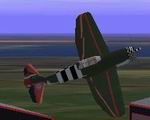 |
| CFS
P47 ' Funderbolt' -
This is a standalone repaint of the stock CFS1 P47 Thunderbolt. In
addition, the *Air file on this aircraft has been altered to make
it it fully aerobatic. It has the Mustang damage profile. Instructions
included. Dan Garner File size: 191K |
|
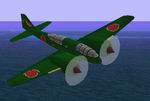 |
| CFS
Mitsubishi Ki46-III Dinah. Original KI 46-III
/ FS98 aircraft, converted to CFS1 with new panel, gunstations and
repainted textures. Mitsubishi's Ki-46 (Type 100 Reconnaissance Aircraft)
series was code-named "Dinah" by the Allies. Original Designer: 'flyman'
Yusaku Honma/1997. Adapted for CFS by Edmundo Abad. 138K |
|
 |
| CFS
Aircraft Mitsubishi A6M3 Type 32 Zero (Hamp). Mitsubishi
A6M3 Zero, of the 204rd Fighter Group, Rabaul, Imperial japanese Navy
Air Force, piloted by Kenji Yanagiya to escort Admiral Yamamoto on
April 18, 1943. The most noticeable design feature of the Type 32
Zero was its clipped wings. This was intended to improve roll rate,
facilitate quicker handling on aircraft carriers and to take advantage
of the uprated Sakae 21 engine. In the event most Hamps saw their
deployment from land based airstrips in the southern island chains
of New Guinea and the Philippines. Original design for FS98: 'flyman'
Yusaku Honma. Original Panel: Mike Colclough (Zero A6M5) New textures,
damage profile, modified panel: Edmundo Abad. 270K |
|
 |
|
CFS
Aircraft Japanese Navy experimental Jet attacker Nakajima Kikka.
The Nakajima Kikka (Orange Blossom), was clearly inspired by
the German Me 262 jet fighter, and was the only World War II Japanese
jet aircraft capable of taking off under its own power. The first
prototype was ready by August 1945. Lieutenant Commander Susumu
Takaoka made the first flight on August 7 (a day after of Hiroshima).
Development of the Kikka ended four days with the Japanese surrender.
Original design for FS98: 'flyman' Yusaku Honma. Original Me-262
Panel: Bernd Drefahl. Original Me-262 Gauges: Stefan Geissler. Conversion
with new damage profile and textures by Edmundo Abad. 1.4MB
|
|
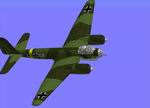 |
| CFS
Ju88A4 3 Schemes.
A repaint of Herve Devred's excellent Ju88A4 with a choice of three
different colour schemes. European, North African and Russian winter.
Included is a modified version of Sergei Golovachev's highly realistic
Ju88 panel. Arno Brooks. 282K |
|
 |
| CFS
Reggiane 2000/II Falco.
Original CFS aircraft of I Soliti Quattro Gatti (IS4G) Group, repainted
with textures of Regia Marina catapulted version. Some Re2000 were
modified for naval roles (Re2000/II version), serving experimentally
as on-board fighters on Regia Marina battleships and cruisers, much
in a similar way to the catapulted hurricanes called "Hurricats".
Original design: Bertil Nilsson \ Andrei Kobakhidze (2000) First IS4G
repaint: TJD, November 2000 New textures, guns profile (2x12.7mm +
2x7.7mm + bomb release), modified Radio Navigation panel: Edmundo
Abad. 297K |
|
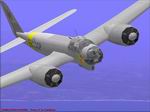 |
| CFS
Ju88D2 reconnaissance aircraft.
A repaint of Herve Devred's excellent model. The Ju88D series was
the standard German reconnaissance plane and flew in every theatre
of war. Included is a modified version of Sergei Golovachev's highly
realistic Ju88 panel. Arno Brooks. 327K |
|
 |
| Stock
CFS1 P51D Repaint. 9th AAF "Hells Belles" This
is a repaint of the stock CFS1 P51D Mustang. It utilizes stock P51D
panels, sound and gauges. I edited the airfile slighty to give it
a better roll rate, and also added more drag to the flaps, so 85 to
88% throttle is needed to land at designated checklist speeds. I have
given it a custom checklist to reflect those characteristics. See
the README file for ways to EASILY repaint this aircraft, as I have
totally redone the bitmaps, so you can clearly see how to do it. Rick
Herring. 682K |
|
 |
|
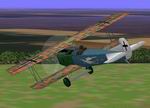 |
| CFS1
WW1 Fokker D.VII biplane fighter The
Fokker D.VII became a favorite of Germany's Aces of the air in the
first World War because of its ability to hold a steep climb without
stalling and also to hold high altitudes from which it could drop
down on enemy craft. First delivered in May of 1918 to the front,
it immediately became a feared opponent of the Allied pilots. Like
the original, the simulation is a very nervous and powerful fighter,
ideal to have a try at zone combat. The model is painted to represent
the Fokker VII "Stork", flown by Uffg Piel, from Jasta 13 during 1918.
Adapted for CFS1 with new Texture, Air and Dp file June 2003 A.F.Scrub.
107K |
|
 
|
|
|
| |










